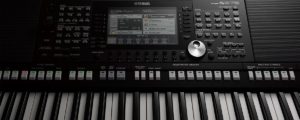Yamaha are announcing two new models in the arranger workstation line: The PSR-S975 and the PSR-S775
The PSR-S975 is an update to the current PSR-S970. New features include:
- Half bar fill-in
- Mono legato operation
- Store and recall of Live Control settings in registration memory
- More preset styles (523, up from 450)
- More Super Articulation voices (140, up from 131)
- More Live voices (99, up from 89)
- Larger expansion memory (768MB, up from 512MB)
- Expansion audio styles (128MB maximum)
Expansion packs like Euro Dance and Salsa are pre-installed. [Click image below to enlarge.]

Quoting the Yamaha Web site:
- 1625 Voices, including Super Articulation Voices, Organ Flutes! Voices. 55 Drum/SFX kits, and 480 XG voices
- 523 Styles, including 40 Audio Styles, 34 Session Styles, 15 DJ Styles and 3 Free Play
- Half bar fill-in and Mono legato function
- 768 MB on-board memory for expansion data
- Mic/Guitar input for use when singing or collaborating with other performers
- Vocal Harmony 2 and Synth Vocoder functions
- Real Distortion and Real Reverb, with an intuitive effects interface
- USB audio playback with time stretch, pitch shift, vocal cancel and MP3 lyrics display functions
- External display capability
The PSR-S775 also received a modest refresh versus the PSR-S770.
Observations
I honestly didn’t expect to see a mid-range refresh this January (2018). Genos™ is barely launched in North America with Winter NAMM 2018 just two weeks away. Yamaha normally announces new arranger workstation products in the Fall. From the marketing point of view, it would have been shear madness to refresh the mid-range while launching Genos during Fall 2017.
I suspect that the refresh is in response to the new Korg Pa700 and Pa1000 mid-range arranger keyboards. Korg and Yamaha are really duking it out in these lucrative segments. The S975 and Pa1000 attract “pro-sumer” musicians and the very affordable S775 and Pa700 are near the magic $1000 USD sweet spot.
Fans expecting a “mini-Genos” will just have to wait. Genos is way too hot to spoil by releasing a mid-range model with Genos-like features. Having played and experienced Genos for nearly one month, the enormous difference in street price between S975 and Genos is (and must be!) justified by a wide gap in functionality and sound quality. Value proposition, folks, value proposition.
One must wonder if a similar product strategy will play out in Yamaha’s synthesizer product line. The MOXF is due for at least a refresh. Does Yamaha have a compelling reason to issue a “Half Monty” two years after the Montage launch? A MOXF refresh might be enough to keep customers interested and sales up given the workstation features (sequencing, sampling, …) left out of the Montage. Some change is due simply because Yamaha’s inventory of the old tone generator IC (SWP51L) must be getting low.
The S975 is probably a simple re-spin of the S970 hardware. Yamaha can ride the ONFI NAND flash memory curve for years to come without breaking a sweat. The switch to ONFI compatible memory makes it easy to drop a larger capacity device into the existing printed circuit board footprint.
I’m still trying to discern where Yamaha are going with audio styles. They do have their patent portfolio covering full audio styles. The S975 allocates 128MBytes for Audio Style Expansion. (The S775 does not.) The Genos has a comparable Audio Style Expansion capability which draws from its Internal Memory. My intuition says that something is afoot, but it’s easy to extend one’s expectations beyond the current hardware/software platform.
There are rumors of another Genos update in the works. As with all things Yamaha, we must wait and see. Fortunately, we have excellent instruments to keep us busy and entertained!
Copyright © 2018 Paul J. Drongowski

